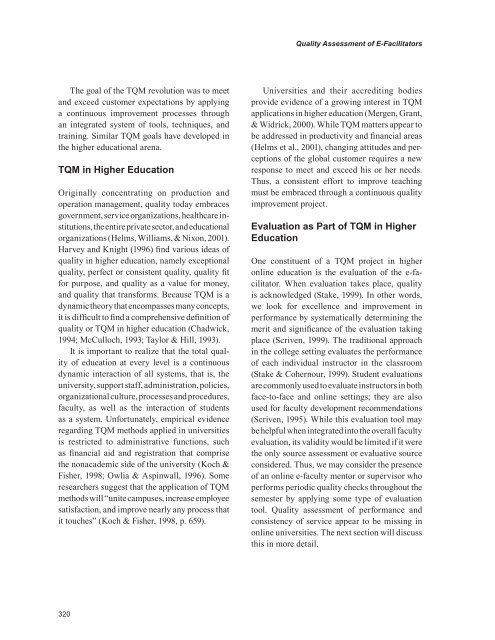Advances in E-learning-Experiences and Methodologies
You also want an ePaper? Increase the reach of your titles
YUMPU automatically turns print PDFs into web optimized ePapers that Google loves.
Quality Assessment of E-Facilitators<br />
The goal of the TQM revolution was to meet<br />
<strong>and</strong> exceed customer expectations by apply<strong>in</strong>g<br />
a cont<strong>in</strong>uous improvement processes through<br />
an <strong>in</strong>tegrated system of tools, techniques, <strong>and</strong><br />
tra<strong>in</strong><strong>in</strong>g. Similar TQM goals have developed <strong>in</strong><br />
the higher educational arena.<br />
tQm <strong>in</strong> higher education<br />
Orig<strong>in</strong>ally concentrat<strong>in</strong>g on production <strong>and</strong><br />
operation management, quality today embraces<br />
government, service organizations, healthcare <strong>in</strong>stitutions,<br />
the entire private sector, <strong>and</strong> educational<br />
organizations (Helms, Williams, & Nixon, 2001).<br />
Harvey <strong>and</strong> Knight (1996) f<strong>in</strong>d various ideas of<br />
quality <strong>in</strong> higher education, namely exceptional<br />
quality, perfect or consistent quality, quality fit<br />
for purpose, <strong>and</strong> quality as a value for money,<br />
<strong>and</strong> quality that transforms. Because TQM is a<br />
dynamic theory that encompasses many concepts,<br />
it is difficult to f<strong>in</strong>d a comprehensive def<strong>in</strong>ition of<br />
quality or TQM <strong>in</strong> higher education (Chadwick,<br />
1994; McCulloch, 1993; Taylor & Hill, 1993).<br />
It is important to realize that the total quality<br />
of education at every level is a cont<strong>in</strong>uous<br />
dynamic <strong>in</strong>teraction of all systems, that is, the<br />
university, support staff, adm<strong>in</strong>istration, policies,<br />
organizational culture, processes <strong>and</strong> procedures,<br />
faculty, as well as the <strong>in</strong>teraction of students<br />
as a system. Unfortunately, empirical evidence<br />
regard<strong>in</strong>g TQM methods applied <strong>in</strong> universities<br />
is restricted to adm<strong>in</strong>istrative functions, such<br />
as f<strong>in</strong>ancial aid <strong>and</strong> registration that comprise<br />
the nonacademic side of the university (Koch &<br />
Fisher, 1998; Owlia & Asp<strong>in</strong>wall, 1996). Some<br />
researchers suggest that the application of TQM<br />
methods will “unite campuses, <strong>in</strong>crease employee<br />
satisfaction, <strong>and</strong> improve nearly any process that<br />
it touches” (Koch & Fisher, 1998, p. 659).<br />
Universities <strong>and</strong> their accredit<strong>in</strong>g bodies<br />
provide evidence of a grow<strong>in</strong>g <strong>in</strong>terest <strong>in</strong> TQM<br />
applications <strong>in</strong> higher education (Mergen, Grant,<br />
& Widrick, 2000). While TQM matters appear to<br />
be addressed <strong>in</strong> productivity <strong>and</strong> f<strong>in</strong>ancial areas<br />
(Helms et al., 2001), chang<strong>in</strong>g attitudes <strong>and</strong> perceptions<br />
of the global customer requires a new<br />
response to meet <strong>and</strong> exceed his or her needs.<br />
Thus, a consistent effort to improve teach<strong>in</strong>g<br />
must be embraced through a cont<strong>in</strong>uous quality<br />
improvement project.<br />
Evaluation as Part of TQm <strong>in</strong> higher<br />
education<br />
One constituent of a TQM project <strong>in</strong> higher<br />
onl<strong>in</strong>e education is the evaluation of the e-facilitator.<br />
When evaluation takes place, quality<br />
is acknowledged (Stake, 1999). In other words,<br />
we look for excellence <strong>and</strong> improvement <strong>in</strong><br />
performance by systematically determ<strong>in</strong><strong>in</strong>g the<br />
merit <strong>and</strong> significance of the evaluation tak<strong>in</strong>g<br />
place (Scriven, 1999). The traditional approach<br />
<strong>in</strong> the college sett<strong>in</strong>g evaluates the performance<br />
of each <strong>in</strong>dividual <strong>in</strong>structor <strong>in</strong> the classroom<br />
(Stake & Cohernour, 1999). Student evaluations<br />
are commonly used to evaluate <strong>in</strong>structors <strong>in</strong> both<br />
face-to-face <strong>and</strong> onl<strong>in</strong>e sett<strong>in</strong>gs; they are also<br />
used for faculty development recommendations<br />
(Scriven, 1995). While this evaluation tool may<br />
be helpful when <strong>in</strong>tegrated <strong>in</strong>to the overall faculty<br />
evaluation, its validity would be limited if it were<br />
the only source assessment or evaluative source<br />
considered. Thus, we may consider the presence<br />
of an onl<strong>in</strong>e e-faculty mentor or supervisor who<br />
performs periodic quality checks throughout the<br />
semester by apply<strong>in</strong>g some type of evaluation<br />
tool. Quality assessment of performance <strong>and</strong><br />
consistency of service appear to be miss<strong>in</strong>g <strong>in</strong><br />
onl<strong>in</strong>e universities. The next section will discuss<br />
this <strong>in</strong> more detail.<br />
0


